Dr Neil Dodgson,
University of Cambridge
Computer Laboratory
Part II course, 1998
Lecture 2 Index
...back to lecture 1
Part A: Conics, quadrics, and superquadrics
Part B: Generative models
Part C: Converting primitives to polygons
on to lecture 3...
2B) Generative models
Sweeps
These are three dimensional objects generated by sweeping a
two dimensional shape along a path in 3D. Two special cases of the
sweep are surfaces of revolution, where the path is
a circle; and extrusions, where the path is a straight line.
Surfaces of revolution are covered in R&A section
6-2. Sweeps are covered in R&A section
6-3 and FvDFH section 12.4.
Extrusion
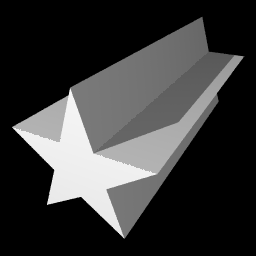
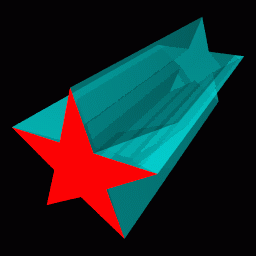
On the left (above) is an example extrusion. On the right is its generating polygon (the red star), with the generated 3D object shown in semi-transparent cyan.
Surface of revolution
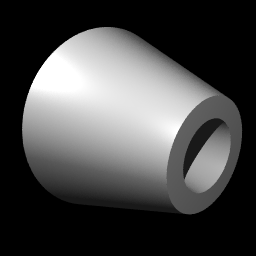
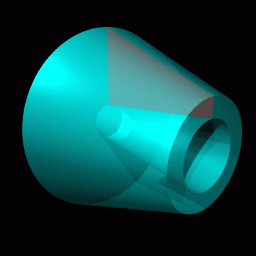
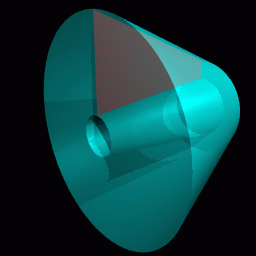 On the left
(above) is an example surface of revolution. On the right (above) is
its generating quadrilateral (the red polygon), with the generated 3D
object shown in semi-transparent cyan. Below that is another view of
the same surface of revolution.
On the left
(above) is an example surface of revolution. On the right (above) is
its generating quadrilateral (the red polygon), with the generated 3D
object shown in semi-transparent cyan. Below that is another view of
the same surface of revolution.
Revolution or extrusion?
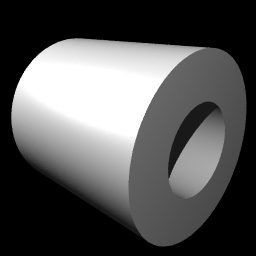
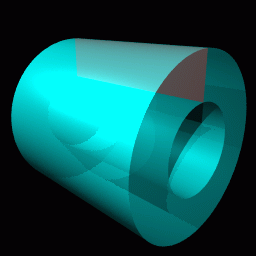
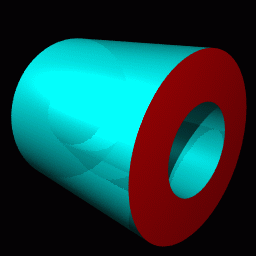 Some objects can be generated in more than one way. The hollow
cylinder shown above (left) could be generated as either a surface of
revolution (above right) or as an extrusion (immediately right).
Some objects can be generated in more than one way. The hollow
cylinder shown above (left) could be generated as either a surface of
revolution (above right) or as an extrusion (immediately right).
Generalised Cylinders
Pushing the idea of sweeps to its limit brings us to generalised
cylinders. Here you may specify any or all of the following things to
produce a three dimensional swept shape:
-
Cross section
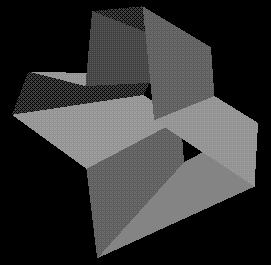
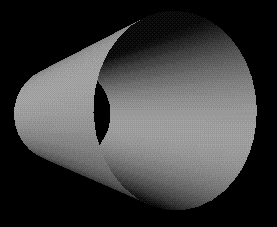 Some two dimensional shape that is to be swept along the
sweep path. This is the cross section of the "cylinder". It does not
have to be circular. At right are two generalised cylinders, one with a circular cross-section, one with a polygonal cross-section.
Some two dimensional shape that is to be swept along the
sweep path. This is the cross section of the "cylinder". It does not
have to be circular. At right are two generalised cylinders, one with a circular cross-section, one with a polygonal cross-section.
-
Sweep path
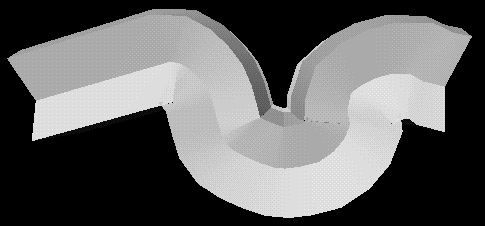
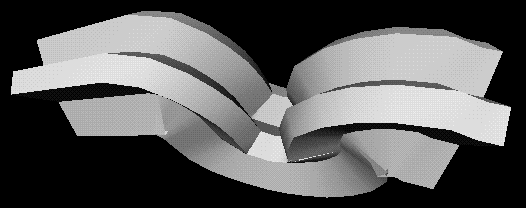 The path along which the two dimensional cross section is
swept to produce the three dimensional shape. It may be any curve. At right we see two views of the same generalised cylinder: a polygonal cross-section is swept along a convoluted path.
The path along which the two dimensional cross section is
swept to produce the three dimensional shape. It may be any curve. At right we see two views of the same generalised cylinder: a polygonal cross-section is swept along a convoluted path.
-
Twist
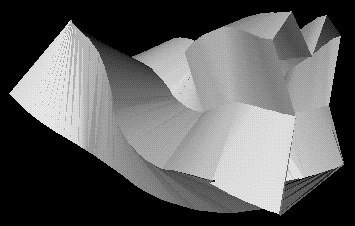
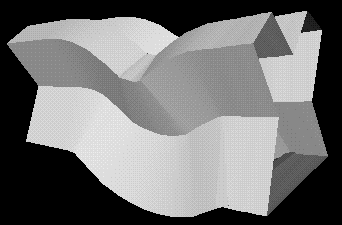 How the cross section twists (rotates) as it moves along
the sweep path. The default would be to have no twist at all. At right is a generalised cylinder with and without some twist.
How the cross section twists (rotates) as it moves along
the sweep path. The default would be to have no twist at all. At right is a generalised cylinder with and without some twist.
-
Scale


How the cross section scales (changes size) as it moves along the
sweep path. The default would be to have it stay the same size along
the whole path. Above are a cylinder, and the same cylinder with
different scales along its length.
-
Normal vector direction
The normal vector of the 2D cross section will usually
point along the sweep path at each point. Changing this will change the
nature of the generalised cylinder. See R&A Figure 6-17
for an example.
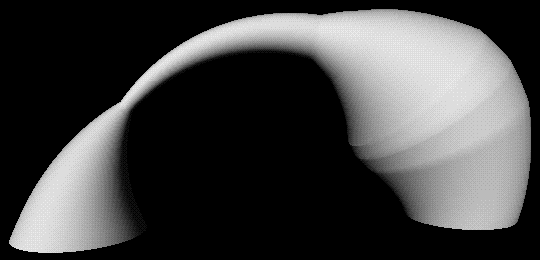 At right is a generalised cylinder with a circular cross-section,
semi-circular path, and varying scale.
At right is a generalised cylinder with a circular cross-section,
semi-circular path, and varying scale.
You may be able to think of parameters, other than those in the list
above, which you could modify to make an even more generalised
cylinder.
Exercises
- [1998/7/12] Show how the following object can be represented as a
swept object.
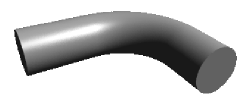
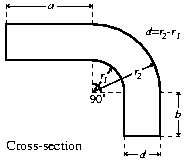
- Use the following different methods of specifying a geometrical
model for this picture (assuming it's a three dimensional model and not
a line drawing). Come as close as you can to the original for any of the
methods, and describe the difficulties in using a particular method for
this model.
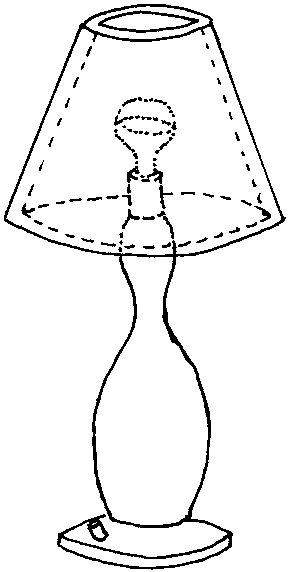
- Extrusions
- Surfaces of revolution
- Sweeps
- Generalized cylinders
- For each of the following categories list five real-world objects
which could be represented by the primitives in the category.
- The ray-tracing primitives in Lecture 1C
- Extrusions
- Surfaces of revolution
- Generalized cylinders
- A flume (water tunnel) at a swimming complex is modeled as a
circle swept along a particular path. The designers also want to model
the volume swept out by a person traveling down the flume. (We can
approximate the cross-section of a person with something roughly
elliptical and we'll assume the `virtual' person doesn't move legs or
arms while hurtling along.) Explain why a standard `sweep' is
insufficient to do this and explain what form of generative model
would be needed to model the volume swept out by a person traveling
down the flume.
|
Lecture 2 Index
...back to lecture 1
Part A: Conics, quadrics, and superquadrics
Part B: Generative models
Part C: Converting primitives to polygons
on to lecture 3...
Neil Dodgson |
Advanced Graphics |
Computer Laboratory
Source file: l2b.html
Page last updated on Mon Sep 7 12:47:50 BST 1998
by Neil Dodgson
(nad@cl.cam.ac.uk)




 On the left
(above) is an example surface of revolution. On the right (above) is
its generating quadrilateral (the red polygon), with the generated 3D
object shown in semi-transparent cyan. Below that is another view of
the same surface of revolution.
On the left
(above) is an example surface of revolution. On the right (above) is
its generating quadrilateral (the red polygon), with the generated 3D
object shown in semi-transparent cyan. Below that is another view of
the same surface of revolution.


 Some objects can be generated in more than one way. The hollow
cylinder shown above (left) could be generated as either a surface of
revolution (above right) or as an extrusion (immediately right).
Some objects can be generated in more than one way. The hollow
cylinder shown above (left) could be generated as either a surface of
revolution (above right) or as an extrusion (immediately right).

 Some two dimensional shape that is to be swept along the
sweep path. This is the cross section of the "cylinder". It does not
have to be circular. At right are two generalised cylinders, one with a circular cross-section, one with a polygonal cross-section.
Some two dimensional shape that is to be swept along the
sweep path. This is the cross section of the "cylinder". It does not
have to be circular. At right are two generalised cylinders, one with a circular cross-section, one with a polygonal cross-section.

 The path along which the two dimensional cross section is
swept to produce the three dimensional shape. It may be any curve. At right we see two views of the same generalised cylinder: a polygonal cross-section is swept along a convoluted path.
The path along which the two dimensional cross section is
swept to produce the three dimensional shape. It may be any curve. At right we see two views of the same generalised cylinder: a polygonal cross-section is swept along a convoluted path.

 How the cross section twists (rotates) as it moves along
the sweep path. The default would be to have no twist at all. At right is a generalised cylinder with and without some twist.
How the cross section twists (rotates) as it moves along
the sweep path. The default would be to have no twist at all. At right is a generalised cylinder with and without some twist.


 At right is a generalised cylinder with a circular cross-section,
semi-circular path, and varying scale.
At right is a generalised cylinder with a circular cross-section,
semi-circular path, and varying scale.